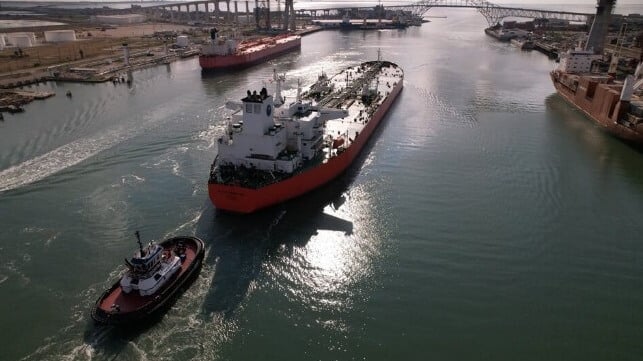Corpus Christi Expansion Sets Up Port to Fulfill Trump’s Energy Export Goal

The Texas Port of Corpus Christi is moving to cement its leadership in energy exports highlighting the recent completion of a massive $625 million channel improvement project. The port says the project was three decades in the making, but that it positions it as the U.S. gears to increase hydrocarbon exports reinvigorated by President Donald Trump’s policies.
Corpus Christi highlights that the port is already a leading U.S. energy export gateway and a major economic engine of Texas and the nation. The Port of Corpus Christi is the third-largest port in the United States in total waterborne tonnage and the port authority reports it moves more than 2.4 million barrels per day of crude oil to points outside the U.S. The port is also the second-largest U.S. gateway for liquefied natural gas exports.
The Channel Improvement Project saw the deepening of the Corpus Christi Ship Channel from 47 feet mean lower low water (MLLW) to 54 feet MLLW. It also involved the widening of the channel from 400 to 530 feet with additional barge shelves. The project was conceived 35 years ago and was implemented in four phases, with construction commencing in 2017.
Phase 1 involved digging the channel from the Gulf of Mexico to Harbor Island while Phase 2 entailed dredging from Harbor Island to the west of the La Quinta junction. For Phase 3, dredging works saw the channel extended from La Quinta to Chemical TB with the last phase entailing the deepening and widening of the channel from Chemical TB to Viola TB. Overall, the project improved approximately 11.9 miles of the channel.
About five million cubic yards of dredged material from the project went into restoring marshes in the Corpus Christi and Nueces bays. It also constructed a 2,000-foot breakwater—to tie into a currently planned 4,000-foot breakwater—in the Nueces Delta.
Being a capital-intensive undertaking, the project was funded through Corpus Christi's internal resources, federal budget allocated by Congress, the U.S. Army Corps of Engineers, and private marine companies.
The newly expanded waterway is expected to facilitate safe, navigable commerce for larger vessels and two-way traffic, enabling more efficient transport of crude oil, LNG, and other commodities. By enabling the movement of larger vessels including very large crude carriers, exporters are projected to save in excess of $200 million in annual transportation costs.
Completion of the project comes when Corpus Christi is recording steady growth in cargo throughput. During the first quarter of this year, the port recorded a five percent increase in throughput, moving 51.3 million tonnes of commodities. The increase was driven primarily by a surge in crude oil and LNG shipments. Crude oil shipments increased by 10.5 percent to 33.4 million tonnes while LNG volumes were up 12.3 percent to 4.3 million tons. Increases were also recorded in dry bulk and breakbulk commodities. In 2024, the port moved a record 206.5 million tonnes of cargo.
Houston a competing port to Corpus Christi located further northeast on the Gulf Coast also recently reported that it will be expanding its channel. In May its port commission reported that the U.S. Army Corps of Engineers (USACE) released its FY25 work plan, which includes $33 million allocated to the Houston Ship Channel Expansion, known as Project 11. Dredging activities are proceeding for another segment of Houston’s channel due to be completed by late Q2 or early Q3 2025.
The expansion of the ports’ capabilities will play another key part in the plan to grow the U.S. industry. Work is also underway on new LNG terminals to increase U.S. exports.
